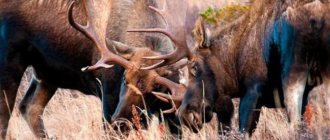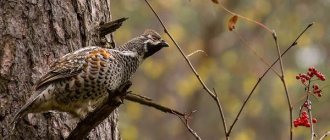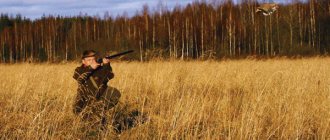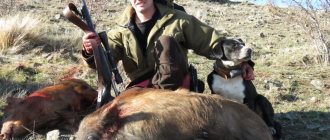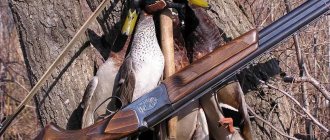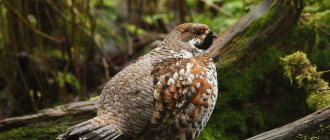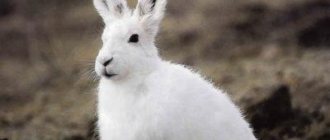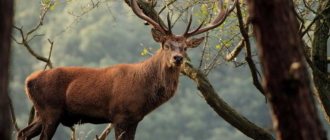Varieties of roe deer
There are two groups of roe deer: Western European and East Siberian; the latter group also includes Caucasian and Central Asian roe deer. The horns of European roe deer rarely reach 30 cm, while in Siberian individuals they reach up to 45 cm in length.
Previously, this species lived mainly in the forest-steppe, but due to agricultural development and shooting, roe deer began to move to more northern areas. Today they can be found in Siberian forests, in the taiga, and in the Caucasus mountains. The main habitats of these animals are river valleys, reed thickets, coniferous and deciduous forests.
Roe deer and musk deer differ little from each other in color. In winter they are dark brown or rusty in color, and in summer they are light gray. In terms of weight, Siberian roe deer are twice as large as Western European ones: the weight of males reaches 59 kg. The body structure of a roe deer is denser than that of an ordinary deer. Unlike deer, roe deer have a tail.
In summer, roe deer happily eat a wide variety of grass and love to visit forest lawns and fields sown with clover. In autumn, roe deer can often be seen in berry fields, where they feast on juicy ripe berries and pick up wild ripe fruits. In winter, roe deer have a hard time. At this time, their diet consists of buds and shoots of trees, acorns, beech nuts, moss, lichens and dry herbs, which they dig out from under the snow. Roe deer need clean running water for drinking several times a day, so they prefer not to move far from rivers or streams.
In the summer, roe deer go out to graze in the late afternoon, when the heat subsides. At the same time, they make small transitions from place to place. At this time, roe deer live alone, not forming a herd and protecting their area from the invasion of strangers. In winter they fatten most of the day. When feeding, the animals behave restlessly, fearing an attack from predators; they constantly look around and listen to unfamiliar sounds.
The roe deer can be considered a sedentary animal; its permanent territory is chosen to be an area of no more than 2 hectares. But in the winter, roe deer migrate to places with little snow, where it is easier to get food. Herds of roe deer often move 100-300 km in search of winter pastures; in the spring they return to their settled places. During such migrations you can meet a herd of up to 50 animals. In autumn, roe deer gather in mixed groups of 20-30 individuals.
Timing and rutting period for roe deer
Unlike other representatives of the deer family, the roe deer's rut begins in early summer and ends in autumn. Males are exceptionally ferocious at this time, especially towards rivals. Their fights often end in death. They also do not treat females very kindly. The male roe deer pursues the female until she gets tired and begins to lie down, then the male makes her get up and continues the pursuit. Often in this kind of pre-wedding race, roe deer move around one tree, trampling a wide path. Having covered one female, the male begins to look for another, and the race is repeated. Roe deer do not form “harems”. After the rut, they begin to gather in small mixed groups to make the autumn transition.
The pregnancy of roe deer is also peculiar; it lasts from 6 to 9 months. The fruit grows if there are good conditions for this, in which case it develops quite quickly. If the female is starving or severe cold occurs, the development of the fetus is suspended. When favorable conditions are created for further development, it begins to grow again. Calving occurs in late spring - early summer. Usually 1-2 cubs are born, although occasionally 3-4 babies are born.
Small roe deer spend the first week of life lying down, hiding in the grass. After a few days, they begin to follow their mother and soon do not leave her a single step. The kids go with their mother all year, but during the rut they try to stay a little away, because a ferocious male can kill an unwary baby. From birth, goats have teeth that fall out when they are 10 years old. Females at this age can still bear offspring. The maximum age of male roe deer is about 16 years, while females live 11-12 years. The first antlers appear on small roe deer at one year of age. After a year, they change; now the horns grow with 2-3 shoots. At the age of 3 years, the roe deer reaches its full bloom.
A simple wooden decoy decoy
An effective homemade roe deer decoy can be made from a suitable piece of wood and cellophane. Unlike the two previous options, this device will be durable. It is difficult to break such a decoy, so it can last for many years. To do it, you need:
- take a wooden cylinder 10 cm long and 1.5 cm in diameter or larger;
- cut it lengthwise into two equal halves;
- in the central part of each half of the cylinder, cut a recess 2 cm long and about a millimeter deep;
- fold the two halves of the cylinder, placing a strip of cellophane about 7 mm wide between them so that it is located in the middle of the gap;
- Secure the semolina halves at both edges using electrical tape.
Instead of electrical tape, you can use thin twine . To make a tongue, a strip of birch bark as thick as tissue paper of the same width - about 7 mm - is suitable. These materials were used earlier, before the spread of cellophane and duct tape.
A wine cork is suitable for making a semolina body. This device turns out to be less convenient to use due to its short length, but it is also effective at luring roe deer. Cork is easy to cut, so making a decoy out of it is very easy. At the same time, this material is much easier to damage than wood.
Hunting with decoy
Roe deer hunting with decoy is carried out from mid-July to the end of summer. However, the most favorable period for this is the first half of August. The fact is that by this time there are fewer and fewer uncovered females ready for procreation, and the males’ rut is not yet over.
Male roe deer willingly imitate the female’s voice (whistle), as well as other sounds: “scream of horror”, explosive whistle. The females and the males accompanying them follow the sounds imitating the voice of a frightened calf. Many hunters make their own decoys. Here is an example of a video of making a roe deer decoy with your own hands.
Hunting for roe deer with a decoy during the rut is very exciting and interesting. Of course, poaching is prohibited by law and licenses are required to hunt ungulates. A hunter can obtain them only by presenting a weapons permit and other documents.
Hunting with decoys during the rut
The choice of hunting time is influenced by the geographical location of the hunting ground. There is an opinion that the best part of the day for hunting is from ten in the morning to three in the afternoon. Hunters often choose the time of dawn to hunt.
The places where the roe deer rut takes place will be easy to recognize by the depressions in the ground to which paths trampled by roe deer lead and by the broken branches of trees in the area. A clear sunny morning after a rainy period is a good time to use a roe deer decoy. At this moment, the animal is hunted by ambush or stealth.
How to beckon from hiding
When hiding, the shelter is installed so that there is a good view. If the animal detects the hunter, he must be able to shoot immediately. Having settled down in a shelter, hide. A pause is needed to eliminate the roe deer’s anxiety. After a while, use a decoy to reproduce the voice of the roe deer. Try to do this quietly. If the animal is close to you, then any loud sound can frighten it.
After 30 minutes, beckon again. The second time you can do this louder. After you whistle, hide for fifteen to twenty minutes, allowing the male to come closer. If the animal comes, but is not close enough, the hunter must use the decoy again. In this case, it is important to make sounds that are extremely similar to the female. Otherwise, you can scare away the approaching male.
From the approach
Stealth hunting will be successful if you have the skills and dexterity. With this type of hunting, remember that the roe deer is a moving animal. The male stands in one place only if the female is next to him. In this case, you won’t be able to lure him with a decoy. You need to approach a lone male very carefully and without the slightest rustle. Two or three minutes later, try whistling the decoy. With an electric decoy, whistle openly, but with a wind decoy, it is better to make a sound through your pocket. Before doing this, calculate from what position you will fire the shot.
Hunting with a decoy can also be carried out after the end of the rutting period. Shooting at such times allows roe deer to become stronger genetically, which contributes to their survival as a species. As is known, females choose the strongest individuals capable of producing strong and healthy offspring, and such males have already covered the females at the beginning of the mating season and satisfied the sexual instinct. The remaining individuals who come to the call of the decoy at the end of the season are not so good for procreation.
Roe deer hunting by stealth
This is one of the most famous ways of hunting roe deer. You should prepare for the hunt in advance; first of all, you need to determine where the animals feed (for this you need to find their traces. See photo). Roe deer usually fatten in overgrown clearings, forest clearings, and forest edges. During daylight hours, roe deer do not appear, preferring to go out to feed after it gets dark. If the roe deer are not too disturbed, then the animals come out to feed at dawn or evening dawn.
In winter, it is not so easy to get food for yourself, so feeding animals can be seen during the day.
It is best to choose clear, slightly windy weather for hunting this species. The wind muffles extraneous sounds, so getting closer to the animals becomes less difficult. You need to go to the intended place of fattening while it is still dark. Usually, while waiting for dawn, the hunter hides near the feeding area of the animals. As soon as it becomes a little lighter and the hunter is convinced of the presence of roe deer, he can begin to sneak up on the grazing animals. We must not forget that roe deer have an excellent sense of smell, so you can only approach the herd against the wind. You should move without making noise and using all available natural shelters.
It is best to take a rifled weapon for such a hunt, since shooting a roe deer with a smoothbore gun is quite problematic. The hunt will be successful only if the hunter is able to get close to the herd and fire an accurate shot.
Despite the fact that hunting in this way is incredibly difficult, it is still very popular among hunters in Siberia and the Far East. Hiding in these areas is made easier by the fact that there are predominantly hilly or mountainous areas covered with forest. If you hunt in winter, you must wear a white camouflage coat; in summer, it is best to wear camouflage clothing.
How to make a decoy from a leaf?
Right on the hunt, you can make a decoy for a roe deer from a leaf of wood. Red beech leaves are very suitable for this, but you can use the foliage of any other tree. The main thing is that the selected leaflet meets the basic requirements:
- he must be young;
- with smooth veins;
- it should not have jagged edges.
To make a decoy, you need to cut the sheet to fit your lips. Then you need to press it to your mouth with both hands, close your lips and blow through them. The edge of the sheet should oscillate at this time. This will produce the same explosive whistle that imitates the voice of a roe deer.
The smaller the distance between the fingers that press the sheet, the higher the sound will be. Thus, with the help of one decoy you can depict the voice of a male, female and cub. A leaf torn from a tree dries quickly, so a new decoy will have to be made quite often.
Ambush hunting
If the population of roe deer in certain areas is large enough, then a hunting method such as ambush shooting is practiced. At the edges of the forest, special bait areas are built, near which a tower is built. The whole hunt consists of the hunter taking his place on the tower and waiting for the moment when the roe deer come to the bait area. After that, all he has to do is fire an accurate shot. This method is often used by hunting workers, as it allows for selective shooting of animals and thereby regulating their numbers.
Ambush hunting can also be carried out during the roe deer rutting period, which usually occurs in August. At this time, males usually go out to graze in the grain fields. Knowing about feeding areas, it is not difficult to build a storage shed nearby and wait for the roe deer to come to the field. Some hunters call this type of hunting resort hunting, most likely because they don’t have to wander the taiga paths for a long time, tracking down the animal. Sitting down in the storage shed, admiring the fiery colors of the sunset, breathing in the clean air of the forests, you can really imagine yourself at a resort. And even if you don’t manage to shoot a roe deer that day, your time still cannot be considered wasted: relaxation and communication with nature will make this evening and this night unforgettable.
What types of decoys are used when hunting roe deer?
All products, including decoys for red deer, presented on the market today, can be divided into two groups:
- electronic;
- homemade.
These products differ from each other not only in cost and principle of operation, but also in the materials used. For beginners, an electronic decoy is better suited, because all the necessary sounds are already programmed into its design. It can make different sounds, including:
- the cry of an excited female;
- the voice of an alarmed female;
- the whistle of a lost cub.
Competition in the sales and production of decoys has led to the appearance of inexpensive electronic devices made from wood on the market. A screw is built into their body, by turning which you can change the frequency of the sound so that the animal listens to exactly the voice that is needed. In addition to the screw inside the structure, there is a metal or plastic tongue.
It is worth remembering that in our country it is forbidden to use such devices when hunting roe deer.
If you use a homemade roe deer decoy, you need to have enough experience so that the sound produced is similar to an animal whistle, and for this you need to learn to listen to this device.
Roe deer hunt
Proper conduct of this mass type of hunting guarantees excellent results. Previously, round-up hunting was very popular, and up to 50 shooters took part in it. Now, no more than 10 hunters participate in a roundup hunt, and the number of shooters directly depends on the number of hunting licenses and the availability of suitable transport.
All hunters must be divided into two groups: shooters and beaters. It is best to make several drives during the day, during which the hunters can change roles. The success of the hunt is primarily due to a good knowledge of the area and the habits of roe deer.
Roundup hunting for roe deer is carried out in the same way as for other ungulates. As a rule, a herd of roe deer consists of a large number of animals, so it is not at all necessary to go around and establish the number of roe deer in the pen.
Roe deer have poor eyesight, so hunters standing at shooting ranges do not have to hide. If they stand without moving, the roe deer will not notice them and will safely approach within gunshot range. The beaters need to make a lot of noise, then the roe deer escape by running quickly and do not pay too much attention to the shooters standing in front. A noisy pen, however, has its drawbacks - animals can move to free flanks. Therefore, experienced hunters advise beaters to make moderate noise and block the free flanks with poles and flags. Even a slight breeze will cause the flags to flutter, which will prevent the roe deer from heading in that direction.
When hunting in this way, it is best to equip the gun with small or medium buckshot. If the roe deer was not killed, but only wounded, it should not be allowed to leave the pen. It is recommended to fire a control shot just in case. If the wounded animal does get away, specially trained dogs will help catch it.
How to make a roe deer decoy with your own hands and hunt with it correctly
Hunting for roe deer with a decoy is effective during the rutting season. It lasts from mid-July to the end of August. The hunting method is to lure the male with sounds that imitate the calling voice of the female, as well as other sounds in the form of a cry of horror, the voice of a small calf, an explosive whistle, which lure the male along with the female.
https://www.youtube.com/watch?v=Z0M2EKrY7y8
Successful hunting occurs in mid-August at the end of the mating season. By this time, the number of females willing to mate decreases, but the males are still ready to breed and are very well attracted.
You can take a rifle for roe deer, either rifled or smooth-bore - the choice depends on the skills of the hunter, the terrain and the terrain. The object of the hunt is large enough for simple shot, so buckshot would be the optimal load. The choice of gun and cartridges for roe deer is described in a separate material. Using a decoy increases the hunter's chances of a successful trophy.
What is gon?
The main rutting period begins in mid-July. The second one will take place in November-December. From mid-summer, females, under the action of endocrine glands and sweat glands, secrete odorous substances. This causes the specific behavior of males during the rutting period. First, the rut begins for roe deer, whose age does not exceed two years. Then it occurs in older individuals.
The rutting period for each female lasts 3-5 days. The males approach the females and begin to chase them. At the stage of preliminary hunting, the female still runs away and does not allow herself to be covered.
The male chases her at a trot or walk in a circle, pressing his nose to the female's tail. As a result, “witch rings” are formed, which are often found in fields and forests.
By being able to read tracks, you can accurately determine at what stage of the rut the roe deer are.
During the second stage of the rut, the males cover the females. He stays with her until the end of the female's rut. After this, it looks for another individual. Already in mid-August, males respond well to the sound of a decoy. Some hunters believe that the entire rutting period is successful for hunting roe deer with a decoy, but this is wrong. At the beginning of the rut, males are not so willing to follow the sound, since there are enough females ready to mate.
Sounds of roe deer
The most important sound that a roe deer makes during the rut is the whistle. This cry of a roe deer in calm weather can be heard from a distance of 150 meters. It is a nasal soft sound “fi”.
Individuals of both sexes emit a whistle, which indicates sexual arousal. The female whistles only when running slowly or if the male is in sight. During other periods, roe deer may whistle for other reasons. The female whistles for her offspring. Small roe deer whistle in a high tone.
An explosive whistle can be heard from a female roe deer. This happens if the male chases her a lot. This sound is two-syllable and resembles “pi-e”, “pi-ya”, “pi-yu”. The emphasis is on the first syllable. The sound can be heard at a distance of 400 meters.
By imitating a whistle, an experienced hunter imitates the voice of a female ready to mate. If you use a decoy, it is best to imitate the explosive whistle of a roe deer. This will attract males, who will think that there is a female nearby, ready to mate, and she is being chased by another male.
If the calf of last year's litter tries to approach the calf that the female brought this year, the little calves cry out in fear, a short-sounding monosyllabic sound "and". Such a scream can be heard 250 meters away.
The imitated sound of a calf's cry attracts females. Following her may come a male who is nearby during the rut and intends to mate with her.
The cry of a calf and explosive whistles lead to anxiety and revitalization of animals; they are allowed to be called only in extreme cases.
Roe deer have a pronounced maternal instinct and herd behavior. Individuals are always ready to help each other, and this can be used when hunting.
Types of decoys
The sounds of roe deer are reproduced by decoys. Various tools are used in the form of a decoy. Some hunters are able to imitate the voice of roe deer without the help of devices. Available materials are also used in the form of leaves of red beech, birch or lilac.
It is safer to use devices specially made for bait. In their design, they have a wooden body, metal inserts and an adjusting screw that can raise or lower the tone of the sound. Experienced hunters recommend making decoy sounds at the beginning of the rutting season, imitating the voice of a young female, and lowering the tone of the sound in August.
Hunting stores offer a large selection of roe deer decoys. They are divided into two types:
Electronic roe deer decoy
The price of an electronic decoy is more than that of a wind decoy. But for novice hunters it is easier to use electronic ones - with their help they can easily produce sounds of the required tone. A blow decoy is more difficult to use because the hunter must correctly imitate the pitch, strength and tone of a roe deer's whistle. This requires training.
But we warn you against training in hunting areas. Roe deer are sedentary animals and can unlearn to respond to sounds made by a decoy. The hunter will not know about this, the animals will not come to him when he hears the sound. For training, it is better to choose a place on the borders of nature reserves. There are animals there, but you won’t come here to hunt. When training, pay close attention to the behavior of roe deer.
Wind decoy for roe deer
There are several types of imitation decoys:
- female voices;
- male voices;
- calf cry.
It is more useful to buy a roe deer decoy that imitates the voice of a female. The sound of a male is unlikely to be useful to you. The hunt is carried out without unnecessary noise. Do not use the whistle too intensively - you may scare away the animal.
DIY roe deer decoy
Hunting for transitional roe deer
This method of hunting is typical for Eastern Siberia, the Far East and Altai. In the autumn or spring, the roe deer migrates from place to place; such an animal is called transitional.
In late autumn, as snow falls, the roe deer leaves its permanent habitat and looks for areas with light snow cover, where it is easier for them to get food. Roe deer can migrate either in small herds or individually. Natural barriers - passes and rivers - do not give roe deer the opportunity to move further, so these animals accumulate not far from them. If the hunter knows the places where there are many animals, all he can do is set up an ambush nearby. The prey on such a hunt is usually plentiful, and this despite the fact that the hunter practically does not have to expend additional effort. Previously, commercial shooting of roe deer was carried out in this way, but now, due to the reduction in the number of these animals, this type of hunting is prohibited everywhere.
What do roe deer voices sound like?
Before you start making a decoy, you need to listen to the voices of male and female roe deer to understand how it should sound. To do this, it is best to go out into the forest in the second half of summer. An easier option is to listen to audio recordings with the voices of roe deer.
During the rut, these animals emit short and long explosive whistles that can be heard at a distance of up to several hundred meters. With the help of such sounds, the female, ready for mating, calls the male to her. The cubs call their mother with thinner squeaks, which can also be imitated using a decoy. Thus, with such devices it is possible to purposefully hunt both male and female roe deer.
With proper skill, the whistles of roe deer can be imitated without any equipment. Some hunters only need their own vocal cords to do this. But it is not easy to portray the voice of an animal in this way, and you need to study for quite a long time in order to freely lure the animal towards you in this way. Using a decoy makes this much easier.
The simplest device for luring an animal is not difficult to make while hunting from natural materials, but it will not last long . By spending a little time, you can make a decoy at home that will last for years. Some are simple in design and easy to make. Others are more complicated - before you start working on such a decoy, it would be a good idea to not only look at the photo, but also study the drawing of such a device.
